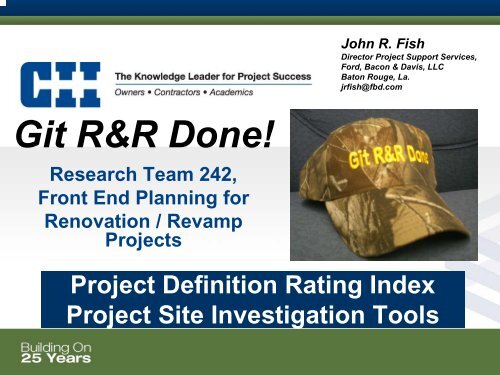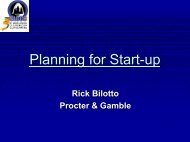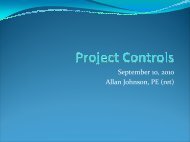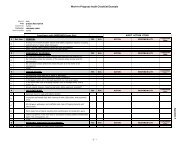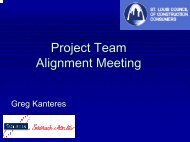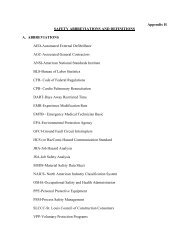Git R&R Done!
Git R&R Done!
Git R&R Done!
Create successful ePaper yourself
Turn your PDF publications into a flip-book with our unique Google optimized e-Paper software.
John R. Fish<br />
Director Project Support Services,<br />
Ford, Bacon & Davis, LLC<br />
Baton Rouge, La.<br />
jrfish@fbd.com<br />
<strong>Git</strong> R&R <strong>Done</strong>!<br />
Research Team 242,<br />
Front End Planning for<br />
Renovation / Revamp<br />
Projects<br />
Project Definition Rating Index<br />
Project Site Investigation Tools
The Rules of the Game<br />
1. Defined, gated Front End Planning process<br />
2. Scope definition tools, such as PDRI<br />
3. Existing conditions definition, site/process<br />
4. Contracting strategy developed<br />
5. Alignment of key stakeholders, team<br />
6. Familiarity with project type, technology or<br />
location<br />
7. Team building of project team<br />
8. Experienced and capable personnel in critical<br />
disciplines<br />
9. Leadership at executive and project level<br />
3
R&R PROJECT MANAGERS
FEP OBJECTIVE<br />
• Define the Scope of work to a degree<br />
that will support the production of a<br />
+10% accurate estimate.<br />
– Identify ANY item that could be of risk.<br />
– Eliminate surprises.<br />
– Improve project success predictability.<br />
5
What Is PDRI<br />
6
PDRI<br />
• An Acronym<br />
– Project Definition Rating Index<br />
• An Index<br />
– Score along a continuum representing the<br />
level of scope definition<br />
• A Risk Management Tool<br />
– Identifies and measures risks related to<br />
project scope definition<br />
7
PDRI OBJECTIVE<br />
• Evaluate the Scope of Work as WE understand it<br />
TODAY!<br />
– Can we estimate it to an accuracy of 10%<br />
– Can we execute:<br />
• On Budget<br />
• On Schedule<br />
• And meet the Owner Business OBJECTIVES<br />
8
SCORE CARD<br />
• Score Card for Completeness of Scope Definition<br />
– Guide to prepare scope of work<br />
– Checklist<br />
– Common Vocabulary and definitions<br />
– Communication Tool between owners and<br />
contractors<br />
– Tool to Identify Potential Areas of Risk<br />
9
THE FAR SIDE<br />
By GARY LARSON<br />
Suddenly, a heated<br />
exchange took<br />
place between the<br />
king and the moat<br />
contractor.<br />
THE FAR SIDE ©1990 FARWORKS,<br />
Inc./<br />
Dist. by UNIVERSAL PRESS<br />
SYNDICATE.<br />
Reprinted with permission.<br />
All rights reserved.<br />
10
OBJECTIVE<br />
PREDICTABILITY<br />
11
FINAL OBJECTIVE<br />
SUCCESSFUL PROJECTS<br />
CONSISTENTLY<br />
Predictable projects<br />
that meet the<br />
business objectives.<br />
12
Project Definition<br />
Rating Index Updates
Updated PDRI Spreadsheets<br />
Your Take-Away Tools<br />
PDRI for Industrial Projects<br />
PDRI for Building Projects<br />
Weighted & Unweighted<br />
Weighted & Unweighted<br />
14
Why Update<br />
• Lacking adequate scope definition for R&R<br />
• Incomplete facility information on R&R<br />
projects<br />
• Critical needs to improve execution:<br />
– Identify existing conditions<br />
– Perform site<br />
investigation/assessment<br />
– Improve site access for front end<br />
planning
The PDRI Updates<br />
• Developed lists of unique R&R Risk issues<br />
- Safety & Environmental - Contracting<br />
- Security & Logistics - Coordination<br />
- Existing Conditions - Compatibility<br />
- Investigation Tools - Demolition<br />
• Coordinated Risk issues for Bldg & Industrial<br />
• Applied Risk issues to PDRI Element<br />
Descriptions<br />
• Additional items to consider for R&R<br />
projects
Examples of R&R Risk Issues<br />
• Modifications to meet existing or<br />
anticipated regulatory requirements<br />
• Worker & occupant safety issues,<br />
exposure, and monitoring during R&R work<br />
• Complete condition assessment of existing<br />
facilities and infrastructure<br />
• Potential reuse of existing equipment,<br />
materials, and systems<br />
• Integration of new technology with existing<br />
systems
The R&R Numbers<br />
• R&R Risk issues:<br />
27 of 64 (42%) Building PDRI Elements<br />
38 of 70 (54%) Industrial PDRI Elements<br />
• Evenly distributed across three PDRI Sections<br />
• R&R impact:<br />
414 of 1000 Building PDRI points<br />
526 of 1000 Industrial PDRI points
PDRI Element Descriptions<br />
(Example)<br />
B4. Design Philosophy<br />
A listing of design philosophy issues should be developed.<br />
These issues should be directed at concerns such as the<br />
following:<br />
Design life<br />
Aesthetic requirements:<br />
Theme or style [such as gothic, Victorian, or modern]<br />
Image (character of occupants or function portrayed to public by the<br />
building, i.e., welcome, power, or nature)<br />
Compatibility with master plan<br />
Environmentally sustainable design (internal/external) and level of<br />
certification, if applicable<br />
Quality of life<br />
Requirements of any adopted anti-terrorism design standards<br />
Other<br />
Additional items to consider for Renovation & Revamp projects<br />
Design impact of Renovation projects<br />
Compatibility of new Design with existing Design (equipment,<br />
egress, etc.)<br />
Match existing features and/or materials<br />
Preservation efforts – cultural & architectural<br />
CII IR 155-2, 3 rd Edition
DEFINITION LEVELS<br />
WELL Defined<br />
POOR<br />
CATEGORY<br />
Element<br />
THIS ELEMENT IS<br />
DEFINED TO SUPPORT A<br />
10% ACCURATE<br />
ESTIMATE<br />
0 1 2 3 4 5<br />
Score<br />
(Not Applicable)<br />
Complete Definition<br />
No further work Required<br />
Minor Deficiencies<br />
No further work Required<br />
Some Deficiencies<br />
Needs more work<br />
Major Deficiencies<br />
Needs LOT more work<br />
Zero Definition<br />
Not to this one YET<br />
21
The Results<br />
• Conducted PDRI 3 rd Edition sessions<br />
Several R&R projects<br />
Both Building & Industrial<br />
• Initial positive results<br />
– Highlighted project issues<br />
– Revealed shortcomings of scope<br />
documents<br />
– Identifies issues of concern in FEP<br />
Updated Excel Spreadsheets developed
Align team w/Objectives<br />
Communicate drivers between<br />
- Business/Sponsors/Contractor<br />
Identify Stakeholder expectations<br />
0<br />
Feasibility<br />
Potential PDRI Application Points<br />
Typical Score: 550-800<br />
Typical Score: 300-450<br />
Align objectives w/stakeholder needs<br />
Identify high priority deliverables<br />
Final review to validate completeness<br />
of definition.<br />
Eliminate late surprises<br />
Definitely should be done on ALL<br />
Facilitate communications across team projects regardless of size or type.<br />
Typical Score: 450-600<br />
1<br />
1<br />
Concept<br />
OPTIONAL: How are we doing<br />
Alignment check: Objectives vs Needs<br />
Resources deployed for highest benefit<br />
Plan the remaining activities<br />
2<br />
2<br />
Typical Score: 150-250<br />
2i<br />
3<br />
Detailed<br />
Scope<br />
3<br />
Design<br />
Constructio<br />
n<br />
23
Project Condition<br />
Investigation Tools<br />
and Technologies
Project Condition Investigation<br />
Categories<br />
• Underground Conditions<br />
• Integrity (Mechanical/Structural/Electrical)<br />
• Restricted Access<br />
• Spatial Relationships<br />
• Risk Identification<br />
• Environmental Constraints
U. G. Site Identification<br />
There IS a<br />
BETTER Way!
Project Condition Investigation<br />
(PCI) Cards<br />
• Current available technologies<br />
• Front end planning investigation<br />
• Risk reduction
PCI Tools & Technologies<br />
No<br />
PCI Card/Technology<br />
Underground<br />
Conditions<br />
Integrity<br />
(Mechanical /<br />
Structural /<br />
Electrical)<br />
Restricted<br />
Access<br />
Spatial<br />
Relationships<br />
Risk<br />
Identification<br />
Environmental<br />
Constraints<br />
1 Ground Penetrating Radar X X X<br />
2 Electromagnetic Sensing X X X<br />
3 Hydro-Excavation X X<br />
4 3D Laser Scanning X X<br />
5 Photogrammetry X X<br />
6 Rapid Prototyping X X X<br />
7 3D Wind Tunnel Modeling X X<br />
8 Ultrasonic Testing X X<br />
9 Hydrostatic Isolation Technologies X X<br />
10 Infrared Scanning X X X X<br />
11 Real Time GPS X X X<br />
12 X-ray Fluorescence X<br />
13 Fiber Optic Sensors X<br />
14 Acoustic Structural Monitoring X<br />
15 Smart PIGS Smart Ball X<br />
16 Magnetic Particle Inspection X<br />
17 Eddy Current Test (ECT) X<br />
18 Liquid Penetrant Inspection X X<br />
19 Flux Leakage X<br />
20 Falling Weight Deflectometer X<br />
21 Mass Spectrometers X X<br />
22 Cost & Schedule Risk Analysis X<br />
23 Conceptual Cost Estimating X<br />
24 SCAPS X
Tool<br />
Alias<br />
Description<br />
Underlying<br />
Technology<br />
Applied<br />
Project<br />
Condition<br />
Service Fee<br />
(unit price)<br />
Benefits/<br />
Features<br />
Limitations<br />
Application<br />
Areas<br />
Service<br />
Providers<br />
Equipment<br />
Suppliers<br />
Other Issues<br />
Ground Penetrating Radar<br />
Ground Probing Radar, Georadar, Subsurface Radar, earth sounding radar, Computer<br />
Assisted Radar Tomography (CART)<br />
Ground-penetrating radar is a geophysical method that uses radar pulses to image the<br />
subsurface. This non-destructive method uses electromagnetic radiation in the microwave<br />
band of the radio spectrum, and detects the reflected signals from subsurface structures.<br />
GPR can be used in a variety of media, including rock, soil, ice, fresh water, pavements and<br />
structures. It can detect objects, changes in material, and voids and cracks.<br />
Noninvasive electromagnetic geophysical technique<br />
Underground Conditions<br />
Spatial relationships<br />
Integrity (Mechanical/Structural/Electrical)<br />
Cost depends on the area surveyed and surface conditions, but is typically between $0.15 to<br />
$.40 per sq ft. A good average cost is about $0.25 per square foot.<br />
Provide high quality, reliable, rapid, and easy to use solutions to subsurface investigation<br />
needs;<br />
Can be performed without interfering with buried utilities;<br />
Detects both metallic and non-metallic materials;<br />
Presents no safety hazards.<br />
Areas with extremely complex subsurface layouts can be extremely difficult to interpret<br />
properly; Sensitive to noise, i.e. interference caused by various geologic and cultural factors<br />
Subsurface survey, structural mapping, forensic investigation, pavement and infrastructure<br />
characterization<br />
Bhate Geosciences Corporation<br />
GeoModel Inc.<br />
AMEC Engineering & Construction Services<br />
And more service providers are listed online at: http://www.g-p-r.com/morecom.htm<br />
Geophysical Survey Systems Inc.<br />
MALÅ<br />
Ground penetrating radar waves can reach depths up to 100 feet (30 meters) in low<br />
conductivity materials such as dry sand or granite. Moist clays, shale, and other high<br />
conductivity materials, may attenuate or absorb GPR signals, greatly decreasing the depth<br />
of penetration to 3 feet (1 meter) or less.<br />
Computer-assisted radar tomography (CART) is a new type of ground-penetrating imaging<br />
radar that can detect and differentiate buried metallic and non-metallic objects and rapidly<br />
generates high-resolution 3D underground images.<br />
Example<br />
PCI Card
When to apply…..<br />
PCI Card Application<br />
0 Feasibility 1 Concept 2<br />
Detailed<br />
Scope<br />
3<br />
Design and<br />
Construction<br />
Front End Planning<br />
Process
PCI Tools Summary<br />
• Define the site CONDITIONS<br />
• Tool Guide<br />
• Easy to Use<br />
• Make decisions in PLANNING
In Summary<br />
• Team Alignment Tool<br />
• Communication Tool<br />
• Assessment Tool<br />
• Common Definitions<br />
• Identifies potential RISK<br />
• Provides Management with Confidence<br />
Use the Spreadsheet with All Stakeholders
MAN DISCOVERS TOOLS<br />
36
OPEN DISCUSSION<br />
FRONT END<br />
in Theory<br />
In Reality
Use the PDRI<br />
Be<br />
Successful!!<br />
38
<strong>Git</strong> R&R <strong>Done</strong>!


